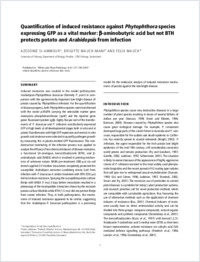Quantification of induced resistance against Phytophthora species expressing GFP as a vital marker: β-aminobutyric acid but not BTH protects potato and Arabidopsis from infection
- Si-Ammour, Azeddine Friedrich Miescher Institute, Basel, Switzerland
- Mauch-Mani, Brigitte University of Neuchâtel, Institute of Botany, Biochemistry Unit, Neuchâtel, Switzerland
- Mauch, Felix Plant Biology, Department of Biology, University of Fribourg, Switzerland
-
2003
Published in:
- Molecular Plant Pathology. - 2003, vol. 4, no. 4, p. 237-248
English
Induced resistance was studied in the model pathosystem Arabidopsis-Phytophthora brassicae (formerly P. porri) in comparison with the agronomically important late blight disease of potato caused by Phytophthora infestans. For the quantification of disease progress, both Phytophthora species were transformed with the vector p34GFN carrying the selectable marker gene neomycine phosphotransferase (nptII) and the reporter gene green fluorescent protein (gfp). Eighty five per cent of the transformants of P. brassicae and P. infestans constitutively expressed GFP at high levels at all developmental stages both in vitro and in planta. Transformants with high GFP expression and normal in vitro growth and virulence were selected to quantify pathogen growth by measuring the in planta emitted GFP fluorescence. This non-destructive monitoring of the infection process was applied to analyse the efficacy of two chemical inducers of disease resistance, a functional SA-analogue, benzothiadiazole (BTH), and β-aminobutyric acid (BABA) which is involved in priming mechanisms of unknown nature. BABA pre-treatment (300 µm) via soil drench applied 24 h before inoculation completely protected the susceptible Arabidopsis accession Landsberg erecta (Ler) from infection with P. brassicae. A similar treatment with BTH (330 µm) did not induce resistance. Spraying the susceptible potato cultivar Bintje with BABA (1 mm) 2 days before inoculation resulted in a phenocopy of the incompatible interaction shown by the resistant potato cultivar Matilda while BTH (1.5 mm) did not protect Bintje from severe infection. Thus, in both pathosystems, the mechanisms of induced resistance appeared to be similar, suggesting that the Arabidopsis-P. brassicae pathosystem is a promising model for the molecular analysis of induced resistance mechanisms of potato against the late blight disease.
- Faculty
- Faculté des sciences et de médecine
- Department
- Département de Biologie
- Language
-
- English
- Classification
- Biological sciences
- License
- License undefined
- Identifiers
-
- RERO DOC 5052
- DOI 10.1046/J.1364-3703.2003.00168.X
- Persistent URL
- https://folia.unifr.ch/unifr/documents/299851
Statistics
Document views: 100
File downloads:
- 1_mauch_qir.pdf: 223
